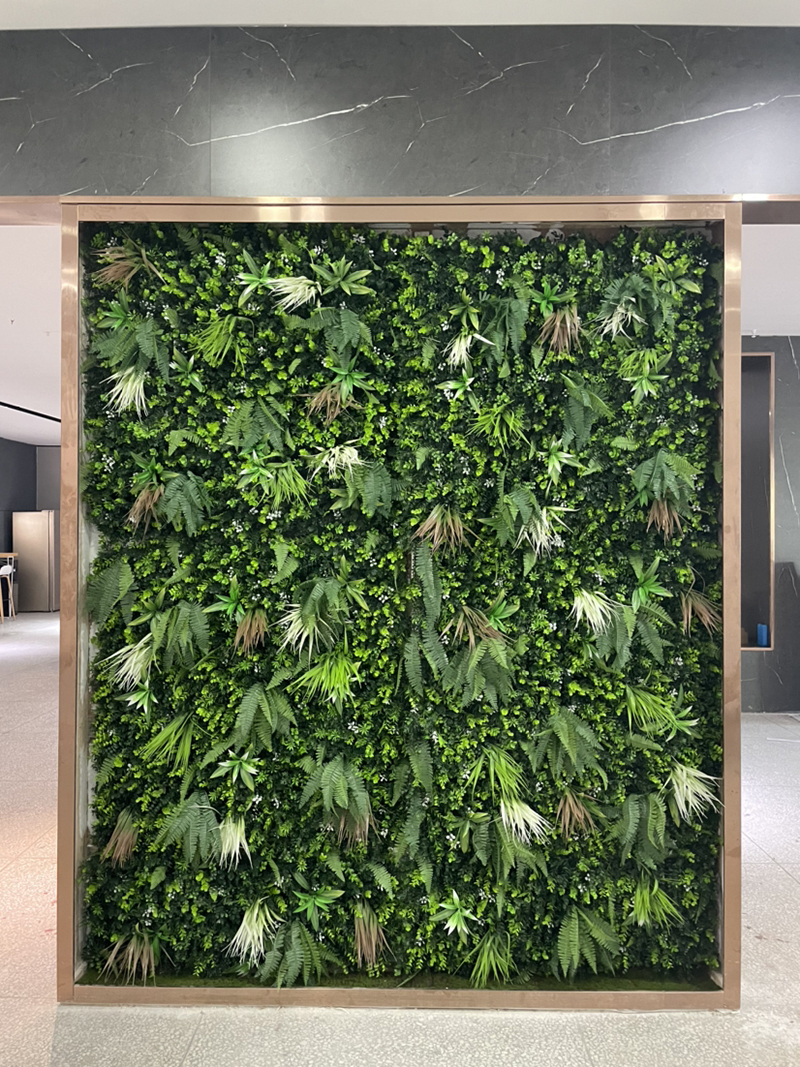In urban environments, noise pollution from traffic, construction, and daily activities poses a significant challenge to quality of life. 3D artificial vertical gardens have emerged as a potential solution, offering both aesthetic and functional benefits, including noise reduction. This article delves into the mechanisms behind their soundproofing capabilities and explores their applications in various settings.
Vertical gardens reduce noise through a combination of physical and biological processes. The dense foliage of plants acts as a natural sound barrier, absorbing and scattering sound waves. Studies indicate that vertical green walls can block 6–8 decibels of noise, a reduction comparable to some traditional soundproofing materials. The leaves, stems, and soil within the garden structure contribute to this effect by converting sound energy into heat through friction and vibration.
Moreover, the layered design of 3D vertical gardens enhances their noise-reduction potential. The use of modular panels filled with lightweight substrates, such as recycled materials or synthetic fibers, creates additional air pockets that further dampen sound. This design mimics the acoustic properties of natural landscapes, where vegetation and soil work together to absorb noise. In urban settings, vertical gardens can be strategically placed near highways, railways, or industrial zones to mitigate noise intrusion into residential or commercial areas.
The integration of vertical gardens into building facades and public spaces offers a sustainable approach to noise management. In offices, vertical gardens can create quieter work environments by reducing external noise from streets or neighboring buildings. This is particularly beneficial in open-plan layouts, where sound reflections can disrupt concentration. By incorporating vertical gardens into interior partitions or atriums, designers can enhance acoustic comfort without sacrificing natural light or space efficiency.
In urban planning, vertical gardens can transform noisy infrastructure into green corridors. For example, planting vertical gardens along elevated highways or subway lines can shield nearby communities from traffic noise. Similarly, in dense urban areas, vertical gardens on rooftops or balconies can act as buffers, reducing noise pollution from surrounding buildings. These installations not only improve acoustic conditions but also contribute to biodiversity and air quality, creating multifunctional green spaces.
Unlike traditional soundproofing materials, such as concrete or acoustic panels, vertical gardens offer additional ecological and aesthetic benefits. While concrete walls can block noise effectively, they often lack visual appeal and may contribute to urban heat islands. Vertical gardens, on the other hand, provide insulation, reduce energy consumption, and enhance biodiversity. Their adaptability to various architectural styles and their ability to integrate with existing infrastructure make them a versatile solution for noise reduction.
However, the effectiveness of vertical gardens depends on factors such as plant density, substrate composition, and maintenance. Dense foliage and regular irrigation are essential to maintaining their acoustic performance. Additionally, the structural integrity of the garden system must be considered to ensure long-term durability. Despite these challenges, vertical gardens represent a promising alternative to conventional soundproofing methods, offering a holistic approach to urban noise management.
As technology advances, the design of vertical gardens for noise reduction is evolving. Researchers are exploring the use of smart materials and sensors to optimize plant selection and irrigation schedules, ensuring maximum noise absorption. For instance, integrating vertical gardens with building management systems could allow for real-time adjustments based on noise levels or environmental conditions.
Furthermore, the development of hybrid systems combining vertical gardens with traditional soundproofing materials is gaining traction. These systems could offer enhanced noise reduction while maintaining the aesthetic and ecological benefits of green infrastructure. In the future, vertical gardens may play a pivotal role in creating quieter, healthier, and more sustainable urban environments.
The soundproofing effects of 3D artificial vertical gardens represent a significant advancement in urban noise management. By leveraging natural processes and innovative design, these installations offer a sustainable alternative to traditional soundproofing methods. As cities continue to grow, the integration of vertical gardens into architectural and urban planning will become increasingly vital, contributing to quieter, greener, and more livable spaces.

Contact: Amy
Phone: 86-15311787313
E-mail: info@foszmac.com
Whatsapp:86-15311787313
Add: Fengtai District, Dacheng Road, No.24 Building, Room 203, Beijing, China